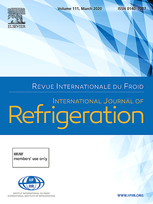
Summary
In this paper, copper foams cured MIL-101(CFCM)/isobutane double-bed adsorption cooling system (ACS) were designed and constructed by using the CFCM unit tube adsorbers. Adsorption cooling characteristic curves of CFCM/isobutane double-bed ACS were studied. Influence of cycle parameters and mass recovery process on the cooling capacity, specific cooling power (SCP) and coefficient of performance (COP) of the CFCM/isobutane double-bed ACS was investigated. Results show that under the conditions of cycle time of 600 s, pre-cooling/pre-heating time of 120 s, condensation temperature of 15°C and hot water temperature of 85°C with the flow rate of 20 L h−1, and cooling water temperature of 14-16°C with the flow rate of 50 L h−1, the cooling capacity, SCP and COP of CFCM/isobutane double-bed ACS is 65.20 kJ kg−1, 108.67 W kg−1 and 0.2260, respectively. Compared with basic cycle, the cooling capacity, SCP and COP of CFCM/isobutane double-bed ACS increases by about 26%, 24% and 22% under mass recovery time of 10 s. The cooling performance of CFCM/isobutane double-bed ACS remains stable after 100 sets consecutive basic cycles and 20 sets mass recovery cycles.
Available documents
Format PDF
Pages: 437-447
Available
Public price
20 €
Member price*
Free
* Best rate depending on membership category (see the detailed benefits of individual and corporate memberships).
Details
- Original title: Experimental study on adsorption cooling performance of copper foams curing MIL-101/isobutane double bed system.
- Record ID : 30029150
- Languages: English
- Subject: Technology
- Source: International Journal of Refrigeration - Revue Internationale du Froid - vol. 131
- Publication date: 2021/11
- DOI: http://dx.doi.org/10.1016/j.ijrefrig.2021.04.018
- Document available for consultation in the library of the IIR headquarters only.
Links
See other articles in this issue (95)
See the source
Indexing
-
Experimental study of the optimal mixing ratio ...
- Author(s) : HELMY M., EL-GHETANY H. H., AHMED M. H., MOSALAM H., ALY W. I. A.
- Date : 2024/11
- Languages : English
- Source: International Journal of Refrigeration - Revue Internationale du Froid - vol. 167
- Formats : PDF
View record
-
Performance study of adsorption refrigeration s...
- Author(s) : XU Q., WU J., XU Z.
- Date : 2021/11
- Languages : English
- Source: International Journal of Refrigeration - Revue Internationale du Froid - vol. 131
- Formats : PDF
View record
-
Novel compact bed design for adsorption cooling...
- Author(s) : MOHAMMED R. H., MESALHY O., ELSAYED M. L., et al.
- Date : 2017/08
- Languages : English
- Source: International Journal of Refrigeration - Revue Internationale du Froid - vol. 80
- Formats : PDF
View record
-
Gradient porosity distribution of adsorbent bed...
- Author(s) : LI M., ZHAO Y., LONG R., LIU Z., LIU W.
- Date : 2021/08
- Languages : English
- Source: International Journal of Refrigeration - Revue Internationale du Froid - vol. 128
- Formats : PDF
View record
-
Active control of supercooling degree using two...
- Author(s) : MATSUMOTO K., UEDA J., EHARA K., et al.
- Date : 2018/01
- Languages : English
- Source: International Journal of Refrigeration - Revue Internationale du Froid - vol. 85
- Formats : PDF
View record
